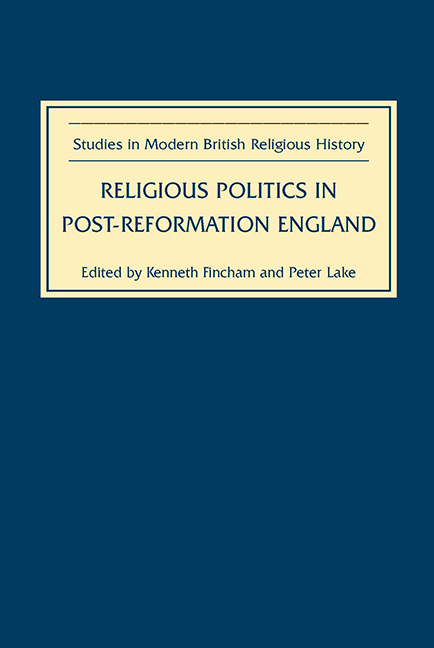Book contents
- Frontmatter
- CONTENTS
- Dedicaton
- Miscellaneous Frontmatter
- Preface
- Abbreviations
- 1 Introduction: Puritanism, Arminianism and Nicholas Tyacke
- 2 Art and Iconoclasm in Early Modern England
- 3 The Latitude of the Church of England
- 4 Joan of Contention: The Myth of the Female Pope in Early Modern England
- 5 Anti-Puritanism: The Structure of a Prejudice
- 6 The Fortunes of English Puritanism: An Elizabethan Perspective
- 7 What's in a Name? Dudley Fenner and the Peculiarities of Puritan Nomenclature
- 8 Puritan Preachers and their Patrons
- 9 New England's Reformation: ‘Wee shall be as a Citty upon a Hill, the Eies of All People are upon Us’
- 10 ‘Anglicanism’ by Stealth: The Career and Influence of John Overall
- 11 Destroyed for doing my Duty: Thomas Felton and the Penal Laws under Elizabeth and James I
- 12 Charles I and Providence
- 13 John Shawe and Edward Bowles: Civic Preachers at Peace and War
- 14 Material Evidence: The Religious Legacy of the Interregnum at St George Tombland, Norwich
- Index
- Tabula Gratulatoria
- Studies in Modern British Religious History
2 - Art and Iconoclasm in Early Modern England
Published online by Cambridge University Press: 25 October 2017
- Frontmatter
- CONTENTS
- Dedicaton
- Miscellaneous Frontmatter
- Preface
- Abbreviations
- 1 Introduction: Puritanism, Arminianism and Nicholas Tyacke
- 2 Art and Iconoclasm in Early Modern England
- 3 The Latitude of the Church of England
- 4 Joan of Contention: The Myth of the Female Pope in Early Modern England
- 5 Anti-Puritanism: The Structure of a Prejudice
- 6 The Fortunes of English Puritanism: An Elizabethan Perspective
- 7 What's in a Name? Dudley Fenner and the Peculiarities of Puritan Nomenclature
- 8 Puritan Preachers and their Patrons
- 9 New England's Reformation: ‘Wee shall be as a Citty upon a Hill, the Eies of All People are upon Us’
- 10 ‘Anglicanism’ by Stealth: The Career and Influence of John Overall
- 11 Destroyed for doing my Duty: Thomas Felton and the Penal Laws under Elizabeth and James I
- 12 Charles I and Providence
- 13 John Shawe and Edward Bowles: Civic Preachers at Peace and War
- 14 Material Evidence: The Religious Legacy of the Interregnum at St George Tombland, Norwich
- Index
- Tabula Gratulatoria
- Studies in Modern British Religious History
Summary
It is usually said that the protestant Reformation severely retarded the development of the visual arts in England. Just when the country was beginning to respond to new Renaissance influences, along came the reformers. The Church, hitherto the main patron of artists, no longer wanted wall-paintings or statues of saints or stained-glass windows. As a result, glass-painting and figure sculpture collapsed, and easel painting was largely confined to secular portraits. Communication with Italy, the centre of artistic innovation, was severely restricted. In Sir Ernst Gombrich's view, the impact of protestantism was a ‘catastrophe’.
Even more devastating than the abrupt check to artistic activity was the wholesale destruction of so much art of the past, the deliberate smashing of statues, obliteration of wall-paintings and breaking of stained glass. Of course, the artistic inheritance of the Middle Ages has suffered from time, neglect and so-called ‘improvement’, as well as from protestant iconoclasts. It is probable that more church monuments and stained glass were removed in the eighteenth and nineteenth centuries than in the sixteenth; and it is certain that, whereas the reformers merely whitewashed over the wall paintings, a reversible process, the Victorians stripped off the plaster altogether. But there can be no denying that reforming zeal led to the destruction of an incalculable quantity of sculpture, wood-carving, painted panels and cloths, mural decoration, embroidery, jewellery, illuminated manuscripts, stained glass and metalwork. Today, for instance, of the alabaster altarpieces that were made in huge numbers in late medieval England, the only complete survivors are ones that were exported; and there is not a single undamaged medieval rood – the crucifix with the statues of the Virgin and St John that once dominated the interior of every village church. In the reign of Edward VI shiploads of discarded Catholic sculpture were sent to the continent; and when a traveller visited Venice in 1594, he found the church of San Giuseppe di Castello full of ‘graven images … of rare beauty’, the ‘chief’ of which were said to have been ‘brought out of England after the death of Queen Mary’.
- Type
- Chapter
- Information
- Religious Politics in Post-Reformation England , pp. 16 - 40Publisher: Boydell & BrewerPrint publication year: 2006



